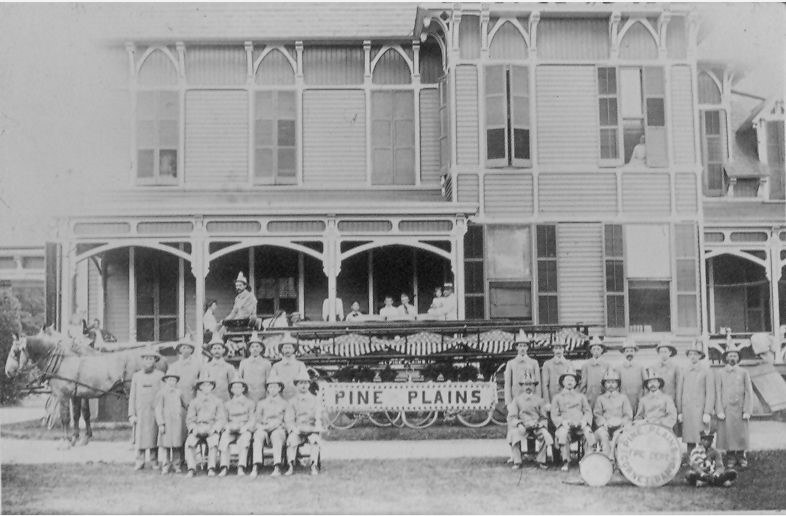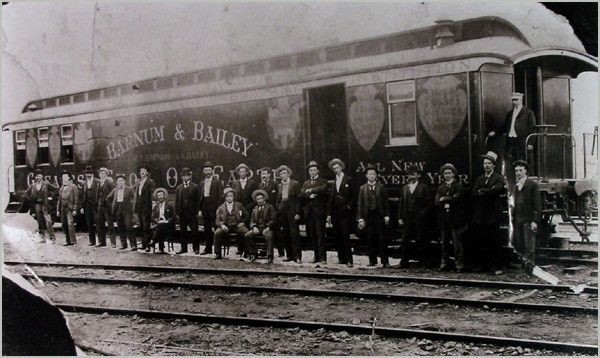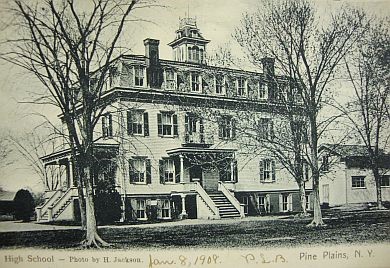About Pine Plains
History
The Little Nine Partners Historical Society…
 We are very fortunate to live in such a beautiful area. But what can be said about its history? When we look at an old building, what do we see? What can it tell us about the past? What is the significance of the clock tower standing prominently in the center of town, and the monument with a German inscription at the corner of Bethel Cross and Strever Farm Roads — what are their stories?
We are very fortunate to live in such a beautiful area. But what can be said about its history? When we look at an old building, what do we see? What can it tell us about the past? What is the significance of the clock tower standing prominently in the center of town, and the monument with a German inscription at the corner of Bethel Cross and Strever Farm Roads — what are their stories?
At first glance, Pine Plains looks like an ordinary, small country town. Like the other towns in Dutchess County, it was created from a larger tract, called a patent, granted by the English Crown to groups of men or companies for speculation. Pine Plains, along with the town of Milan and part of the town of North East, was carved out of the 1706 Little Nine Partners Patent, one of the last in Dutchess County to be granted. But here the similarity ends. Geography would play a significant role in shaping Pine Plains’ development, making it quite different from other towns in the region. Called “the pine plains” for the abundance of pine trees covering its valley floor, the area, bounded on the east and west by mountains, was something of a backwater.
The first European settlers here were Palatine Germans brought over by England in 1710 to produce naval stores. At the time, this was still Mahican (or Mohican) territory. However, Native American society had declined in the face of increasing white encroachment. One brief glimmer of hope was offered by Moravian missionaries who established a mission in 1740 at the little Mahican village of Shekomeko, the single most significant event in Pine Plains history. Yet by 1746 the missionaries and Mahicans were gone, driven out by settlers who claimed the Mahicans’ land. All trace of Shekomeko was plowed under, and soon the people forgot what had happened here. Then in 1859, members of the Moravian Historical Society came from Bethlehem, Pennsylvania to honor the missionaries and their Mahican converts. At a moving dedication ceremony attended by some of the local dignitaries, the gravesite of missionary Gottlieb Büttner, found with the help of a local farmer, was marked by a monument with the German epitaph from his former tombstone inscribed on one side. Although later moved a short distance, to this day the monument bears quiet testimony to the story of Shekomeko.
The years following the Revolution brought people migrating west out of New England, and the region quickly overcame the disadvantages presented by its remote location. Hamlets soon sprang up along the Shekomeko Creek and the Salisbury Turnpike, laid out in 1802. In 1823 the town of Pine Plains was established, taking its name from the old description of the area. Early industries thrived, including a scythe works, a tannery, and scattered small mills, but from its beginnings agriculture drove the town’s economy. Then, after the Civil War, Pine Plains became a railroad hub, bringing further growth.
We can see just from what happened at Shekomeko that the history of Pine Plains was not going to be ordinary. In fact, Pine Plains can lay claim to some impressive “firsts” for a town of its size and location:
- 1742 first congregation of Protestant Native Americans in North America, established by Moravian missionaries at the Mahican village of Shekomeko.
- 1798 first public library in Dutchess County.
- 1931 first centralized school district in Dutchess County.
- 1936 first zoning committee established in New York State to consider passing a zoning ordinance in a rural township (but Pine Plains was the last town in Dutchess County to adopt one, in 2009!).
- 2013 first seed library in Dutchess County.
 How many of these “Fun Facts” and unique things about Pine Plains do you know?
How many of these “Fun Facts” and unique things about Pine Plains do you know?
- Stissing Mountain, the town’s most visible landmark at 1,403 feet, is a unique geological formation, a block of 1.1-billion-year-old Precambrian gneiss “floating” on top of younger shale and sandstone.
- Thompson Pond, part of the Nature Conservancy, is a special type of wetland called a circumneutral bog lake. It is home to New York’s smallest turtle, the endangered bog turtle, and is the source of Wappinger Creek, a major tributary of the Hudson River and largest watershed in Dutchess County.
- Tschoop, one of the “first fruits” (first converts) of the Moravians at Shekomeko, is believed to be the model for Chingachgook in James Fennimore Cooper’s “The Last of the Mohicans”.
- The Graham-Brush House, dated 1750-1770, is one of earliest surviving log structures in the Hudson Valley and oldest house in Pine Plains. It is owned by the Little Nine Partners Historical Society.
- Horse breeding has a long tradition in Pine Plains. Perhaps the most important early American Thoroughbred stallion, Messenger, stood here for several years after his part-owner Cornelius W. Van Ranst brought him to his Pine Plains farm in 1796. He is the foundation sire to several breeds developed in America including the Standardbred, American Saddlebred, and Tennessee Walking Horse. Speaking of horses…horse racing was also big here in the early 1800s and Pine Plains even had its own racetrack, which was located on the empty lot between Stissing Avenue and Lake Road.
- The Stissing House, originally a log tavern built by Captain Cornelius Elmendorph in 1782, has one of the few early domed ballrooms in the country, as well as a rare form of Dutch colonial framing. Although Washington never slept here, the Marquis de Lafayette, hero of the Revolution, most certainly did.

- When Stissing National Bank merged with Bank of Millbrook in 2010, it had been in operation for 171 years (beginning as Pine Plains Bank) and was at that time the oldest business in Pine Plains.
- Built in 1814, the Eno Law Office is one of oldest law offices still standing in New York State.
- Pine Plains is rumored to have been a stop on the Underground Railroad. Although no evidence of this has yet been found, the Presbyterian Church’s minister from 1833-1883, The Rev. William N. Sayre, was a member of the Dutchess County Anti-Slavery Society.
- Pine Plains at one time had two news weeklies, The Pine Plains Herald (1859-1926), and The Pine Plains Register (1882-1926). Samuel Hoag, the long-time publisher and editor of the Herald, was called the “Dean of Dutchess County editors”, and Charles S. Wilber, the publisher of the Register, was called the oldest newspaperman in Dutchess County, and perhaps the Hudson Valley, when he died in 1925 in his 85th year. The newspapers merged in 1926 as The Register-Herald, which folded in 2009, ending 150 years of newspapers in Pine Plains.
- In the late 1800s, Barnum and Bailey Circus boarded show animals over the winter at local farms for $5/month per animal, with a circus employee boarding with the farmer for $10/month.

- John H. Righter, whose game company Selchow & Righter had its first big commercial success with the manufacture of Parcheesi in the late 1800s, was from Pine Plains.
- Seymour Smith Institute, a co-educational boarding school, opened in 1879, the bequest of Seymour Smith. Unique for a rural community at the time, it was noted for its academic excellence and attracted students from as far away as South Carolina. The Pine Plains location was touted for its healthy climate, “free from every form of malarial disease” and “far removed from the temptations incident to large towns and cities.” Closed in 1896, it reopened as Seymour Smith Academy, a union free school and teacher training school. It was torn down in 1932 to make way for the new central school.
- The Pines, the grandest building in Pine Plains, was built in the Stick-Eastlake style in 1878 by lawyer William S. Eno. It had many modern conveniences not yet found in the typical home, such as gas-operated fixtures and indoor plumbing. It became a hotel during the resort era of the early 1900s.
- In 1889 the last remaining lot of the Little Nine Partners Patent (Lot #47) was subdivided and sold at auction after George Clarke IV, a direct descendant of George Clarke, one of the original nine partners, went bankrupt. This lot, held intact by the Clarke family for almost 150 years, had prevented the development of the entire west side of Main Street. News of the sale made The New York Times.
- The Bowman Opera House, built in 1895, was unique for such a small country town. The masquerade balls here became legendary. This is the building where the pharmacy is now.
- Few small volunteer fire companies dating from the 1800s can boast still having any original fire apparatus, but Pine Plains Fire Company has two. The hand-drawn hose cart, purchased in 1896 for $24, was meant to be pulled by six men and hooked up to a hydrant (Pine Plains having recently installed a water works). The hook and ladder wagon, purchased in 1899 for $200, could be pulled by men or a team of horses. Both were on recent loan to the FASNY Museum of Firefighting in Hudson.
- There were 18 trains on three railroads going in and out of the town daily during the railroad’s peak years in the early 1900s. While the trains carried passengers, the hauling of iron ore, followed by milk, were the leading sources of income. After the demise of the railroads in the 1930s, the tracks were pulled up and sold as scrap to Japan.
- Memorial Hall was a gift in 1914 to the town by philanthropist Mary Ellen Lapham Saunders in honor of her maternal grandparents, John and Elizabeth McIntyre, with whom she had lived as a child in Pine Plains, and their children. In 1935 the building was converted into a movie theatre and became a testing site for first run films before they were debuted in New York City. In 1959 it was the original proposed site for Mid-Hudson Library System, but Poughkeepsie was chosen instead.
- Hartwick College in Oneonta, N.Y. is home to the Hoysradt Herbarium, a collection of over 20,000 pressed plants, many of them rare specimens from Pine Plains, collected by amateur botanist and local resident Professor Lyman Henry Hoysradt (1847-1933). It was donated to the college after his death.
- The clock tower was dedicated in 1920 to the memory of Dr. Henry Clay Wilbur (1845-1919) for his 52 years of service to the town. In addition to his private practice, Dr. Wilber was the town health officer for 33 years, coroner for 15 years, charter member and president of the Dutchess County Medical Society, and member of the New York State Medical Society. Quite a resume for a rural doctor!
- Bootlegger and racketeer Dutch Schultz ran an underground distilling operation at Harvest Homestead Farm here during Prohibition, taking advantage of the area’s isolation. It was raided in 1932.
- The former Deuel’s hardware store was a coal and feed business operated by Samuel Deuel in the early 1900s. The main building had been a roller-skating rink which he moved in sections to its present location. The old farmers weigh station out by the road (still functional) was used mostly to weigh bulk items by the truckload before they came prepackaged in standard-sized bags.
- Briarcliff Farms once supplied stock for 95% of the Angus beef cattle in the U.S. It all began in 1907, when Walter Law relocated his massive dairy operation to Pine Plains from Westchester County. Within 3 months he bought up 12 local farms on both sides of present-day Route 82, totaling 3249 acres. In 1918, Oakleigh Thorne purchased Briarcliff and changed over to raising prized Aberdeen Angus cattle.
- President Franklin D. Roosevelt liked to take scenic drives around the lake and picnic here.

- The Pine Plains chapter of Future Farmers of America is one of only two chapters in Dutchess County.
- Pine Plains’ diverse ecology is featured in the Felix M. Warburg Memorial Hall (dedicated 1951) at the American Museum of Natural History in New York City. Most notable is the striking diorama called, “An October Afternoon Near Stissing Mountain”. Dr. Harry L. Shapiro, a Pine Plains summer resident and head of the museum’s department of anthropology, had a leading role in planning this exhibit.
Geography
According to the United States Census Bureau, the town has a total area of 31.2 square miles (80.7 km2). 30.6 square miles (79.2 km2) of it is land, and 0.58 square miles (1.5 km2), or 1.89%, is water. The north town line is the border of Columbia County.
Three small lakes lie west of Pine Plains hamlet: Stissing Lake which is excellent for swimming, Thompson Pond which is dedicated to conservation for wildlife, and Twin Island Lake. S
Communities and Locations
Bethel – A hamlet in the south-central part of town.
Hammertown – A hamlet east of Pine Plains village.
Mount Ross – A location in the northwest corner of the town.
Pachin Mills – A hamlet in the north part of the town near the Columbia County border.
Pine Plains – The hamlet of Pine Plains.
Pulvers Corners – A location in the northeast part of the town.
Culture
Pine Plains is a theater town: the Stissing Theatre Guild was created to support productions at the High School, and we remain the original home of the Tri-Arts Theatre. Numerous artists have studios here, and numerous townspeople make beautiful things and are represented in our local stores. Craftspeople abound, from masons to expert carpenters to fine furniture-makers; and the town is home to many excellent musicians. This is a diverse community with a strong work ethic.
Memorial Hall, right in the center of town, was an old vaudeville house, a gathering place, a movie theater… you name it. Currently under renovation, this beautiful 1915 building will serve as a cultural home for a variety of community-based civic and social programs, agricultural and arts education, a venue for concerts, films and cultural performances, and an incubator for local charitable organizations and entrepreneurs. Due to open in 2019, and designed to be flexible, this will be an addition to our village that welcomes chamber orchestras, lectures, jazz bands, classes, small innovative theatre productions, you name it, with guests and townspeople alike encouraged to create.
 More History
More History
History of Little Nine Partners, of North East precinct, and Pine Plains, New York, Duchess county
by Huntting, Isaac, Publication date 1897
https://archive.org/details/historyoflittlen01hunt
General history of Duchess County, from 1609 to 1876, inclusive
by Smith, Philip Henry, 1842-, Publication date 1877
(Pine Plains, pgs 298-323)
https://archive.org/details/generalhistoryof01smit
